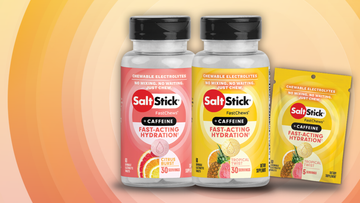
When sodium levels are too low, the body responds with painful symptoms. What exactly causes those nasty headaches, extreme fatigue, and painful muscle cramps?
SaltStick was founded on the knowledge that adequate sodium levels, along with other key electrolytes such as potassium, calcium, and magnesium, are fundamental to athletic endurance. To achieve optimal performance, an athlete needs to replace these electrolytes that are lost during exercise. If they are not replenished, performance can decline, and worse, more serious symptoms may occur.
The importance of sodium
Sodium is crucial to many physiological processes, from muscle contraction to blood pressure management. Sodium also helps regulate the amount of water that is in and around cells. An inadequate supply of sodium in the body can have detrimental effects and can lead to hyponatremia, a condition that occurs when the concentration of sodium in the blood is abnormally low.
When this happens to endurance athletes, it’s usually caused by drinking too much water during exercise, causing the sodium content in the blood to become diluted over time. Water then moves into the body’s cells, and they begin to swell. It is the swelling of the cells that causes symptoms, the most common being nausea, fatigue, and headache. Read on to learn more about some of the symptoms of hyponatremia.
Three common symptoms of hyponatremia
1. Headache
When sodium levels are normal: The concentration of sodium inside the cells (intracellular sodium) is balanced with the concentration of sodium in the plasma outside the cells (extracellular sodium), maintained by normal homeostasis, or self-regulation.
When sodium levels are too low: The concentration of extracellular sodium becomes too low, creating an imbalance. To resolve the difference, the cells absorb excess water causing them to swell in size. When the brain cells absorb extra water, the brain swells and pushes against the skull, which cannot expand. This pressure causes a headache, which can often be severe. The swelling in the brain can cause other symptoms as well, such as personality changes, loss of consciousness, and seizures.
The fix: Seek to balance out sodium and water levels immediately. Do not continue to drink plain water; instead, ensure that you consume sufficient levels of sodium with supplements or broth. Only by rebalancing the levels of sodium in the plasma surrounding the cells will the brain return to normal and relieve the pressure causing a headache.
2. Muscle cramps
When sodium levels are normal: The body’s cells use electrolytes to conduct electrical charges. These charges help the nervous system send signals throughout the body that tell the muscles to contract and relax normally.
When sodium levels are too low: The body’s ability to send signals is interrupted so the brain overcompensates and sends too many electrical impulses. Eventually, these signals overwhelm the muscle, preventing it from relaxing and manifesting in muscle twitches or cramping.
The fix: Stop or slow down activity until cramping subsides. Consuming electrolytes may also help, particularly from a fast-absorbing source like SaltStick FastChews.
3. Nausea
When sodium levels are normal: Cells maintain the right balance of fluid.
When sodium levels are too low: The body reacts to the low sodium by preventing further dilution. In addition to moving water inside the cells, the body prevents any excess water from being consumed through the digestive system. Thus, absorption of water out of the gut is severely restricted, no matter how much the athlete swallows. The result is a stomach full of water that will not digest. During exercise, this can cause nausea.
The fix: Consume a concentrated source of electrolytes that will allow the body to begin absorbing water again. In the future, do not rely entirely on plain water or sports drinks, as they usually are not adequate for replacing the sodium lost through sweat.
Who is most at risk for hyponatremia?
The following people are most susceptible to hyponatremia:
- People with medical conditions such as kidney disease or dysautonomia
- People who take certain medications such as diuretics, as well as some antidepressants, pain medications and recreational drugs
- The elderly
- People who drink too much water while taking part in long endurance exercise or high intensity activities, especially in the heat
How to avoid low sodium levels
Proper electrolyte supplementation prior to and throughout your athletic event, along with appropriate fluid intake, is key to performing your best and avoiding symptoms such as headache, nausea, and muscle cramps. Click here to learn how SaltStick can help you to avoid low sodium levels.
Disclaimer: Contact your physician before starting any exercise program or if you are taking any medication. Individuals with high blood pressure should also consult their physician prior to taking an electrolyte supplement. Overdose of electrolytes is possible, with symptoms such as vomiting and feeling ill, and care should be taken not to overdose on any electrolyte supplement.







